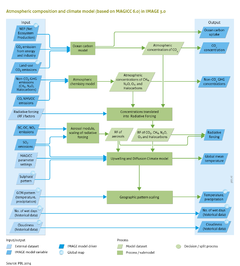Atmospheric composition and climate/Description: Difference between revisions
Jump to navigation
Jump to search
Oostenrijr (talk | contribs) m (Text replace - "CO2 " to "CO<sub>2</sub>") |
Oostenrijr (talk | contribs) m (Text replace - "CO<sub>2</sub>" to "CO<sub>2</sub> ") |
||
| Line 2: | Line 2: | ||
|Reference=Forster et al., 2007; WMO/UNEP, 2013; Meinshausen et al., 2011a; Myhre et al., 2013; Denman et al., 2007; IPCC-DDC, 2007; | |Reference=Forster et al., 2007; WMO/UNEP, 2013; Meinshausen et al., 2011a; Myhre et al., 2013; Denman et al., 2007; IPCC-DDC, 2007; | ||
|Description====Atmospheric gas concentrations=== | |Description====Atmospheric gas concentrations=== | ||
The IMAGE climate model (based on [[MAGICC model|MAGICC 6.0]], [[Meinshausen et al., 2011a]]) calculates atmospheric CO<sub>2</sub>concentration based on CO<sub>2</sub>emission data for energy, industry and land-use change (Component[[Emissions]]); terrestrial carbon balance (Component [[Carbon cycle and natural vegetation]]); and carbon uptake by the oceans (calculated in MAGICC on the basis of the Bern Ocean Carbon model). | The IMAGE climate model (based on [[MAGICC model|MAGICC 6.0]], [[Meinshausen et al., 2011a]]) calculates atmospheric CO<sub>2</sub> concentration based on CO<sub>2</sub> emission data for energy, industry and land-use change (Component[[Emissions]]); terrestrial carbon balance (Component [[Carbon cycle and natural vegetation]]); and carbon uptake by the oceans (calculated in MAGICC on the basis of the Bern Ocean Carbon model). | ||
Concentrations of other long-lived greenhouse gases (CH4, N2O, and halocarbons), and tropospheric ozone (O3) precursors (CO, NMVOC) are calculated by MAGICC in a simple atmospheric chemistry module. Halocarbons and N2O concentrations mostly show a simple mass-concentration conversion and half-life behaviour. CH4 and ozone dynamics are more complex, with CH4 lifetime depending on the OH concentration level, and O3 and OH concentration levels depending on CH4 concentrations, and NOx, CO and NMVOC emissions ([[Meinshausen et al., 2011b]]). | Concentrations of other long-lived greenhouse gases (CH4, N2O, and halocarbons), and tropospheric ozone (O3) precursors (CO, NMVOC) are calculated by MAGICC in a simple atmospheric chemistry module. Halocarbons and N2O concentrations mostly show a simple mass-concentration conversion and half-life behaviour. CH4 and ozone dynamics are more complex, with CH4 lifetime depending on the OH concentration level, and O3 and OH concentration levels depending on CH4 concentrations, and NOx, CO and NMVOC emissions ([[Meinshausen et al., 2011b]]). | ||
Revision as of 10:30, 1 July 2014
Parts of Atmospheric composition and climate/Description
| Component is implemented in: |
|
| Related IMAGE components |
| Projects/Applications |
| Models/Databases |
| Key publications |
| References |
